| Revision as of 02:08, 31 October 2006 editJosiah Rowe (talk | contribs)Administrators31,692 edits →Achilles and Patroclus: "admitted" is too POV for the "they weren't lovers" camp, IMO← Previous edit | Latest revision as of 13:58, 6 January 2025 edit undoJino john1996 (talk | contribs)171 edits Added content and sourceTags: Visual edit Mobile edit Mobile web edit | ||
| Line 1: | Line 1: | ||
| {{short description|Homosexuality in ancient Greek society}} | |||
| {{sprotect-banneduser}} | |||
| {{Primary sources|date=May 2024}} | |||
| ] | |||
| ] | |||
| In ], writers such as ],<ref>Herodotus ''Histories'' {{Webarchive|url=https://web.archive.org/web/20220326212518/http://www.perseus.tufts.edu/hopper/text?doc=Hdt.+1.135&fromdoc=Perseus%3Atext%3A1999.01.0126 |date=2022-03-26 }}</ref> ],<ref>Plato, ''Phaedrus'' {{Webarchive|url=https://web.archive.org/web/20220515215410/http://www.perseus.tufts.edu/hopper/text?doc=Perseus%3Atext%3A1999.01.0174%3Atext%3DPhaedrus%3Asection%3D227a |date=2022-05-15 }}</ref> ],<ref>Xenophon, ''Memorabilia'' {{Webarchive|url=https://web.archive.org/web/20220401022027/http://www.perseus.tufts.edu/hopper/text?doc=Xen.+Mem.+2.6.28&fromdoc=Perseus%3Atext%3A1999.01.0208 |date=2022-04-01 }}, ''Symposium'' {{Webarchive|url=https://web.archive.org/web/20220104200131/http://www.perseus.tufts.edu/hopper/text?doc=Perseus%3Atext%3A1999.01.0212%3Atext%3DSym.%3Achapter%3D8%3Asection%3D1 |date=2022-01-04 }}</ref> ]<ref>Athenaeus, ''Deipnosophistae'' {{Webarchive|url=https://web.archive.org/web/20120728072015/http://www.fordham.edu/halsall/pwh/athenaeus13.html |date=2012-07-28 }}</ref> and many others explored aspects of '''] in Greek society'''. Plato, in his Laws, condemns homosexuality and calls it 'unnatural', although earlier he was favourable towards it.<ref>{{Citation |last=Pickett |first=Brent |title=Homosexuality |date=2021 |work=The Stanford Encyclopedia of Philosophy |editor-last=Zalta |editor-first=Edward N. |url=https://plato.stanford.edu/entries/homosexuality/#:~:text=In%20the%20Laws,%20Plato%20applies,%E2%80%9Cunnatural%E2%80%9D%20(636c). |access-date=2025-01-06 |edition=Spring 2021 |publisher=Metaphysics Research Lab, Stanford University}}</ref> The most widespread and socially significant form of same-sex sexual relations in ancient ] amongst elite circles was between adult men and pubescent or adolescent boys, known as ] (marriages in Ancient Greece between men and women were also age structured, with men in their thirties commonly taking wives in their early teens).<ref>Xen. Oec. {{Webarchive|url=https://web.archive.org/web/20220322062925/https://www.perseus.tufts.edu/hopper/text?doc=Perseus:text:1999.01.0212:text=Ec.:chapter=7:section=5 |date=2022-03-22 }}</ref> Certain city-states allowed it while others were ambiguous or prohibited it.<ref>{{Cite book|last=Cohen|first=David|title=Law, Sexuality, and Society: The Enforcement of Morals in Classical Athens|publisher=Cambridge University Press|year=1994|isbn=9780521466424|location=Cambridge University|pages=6}}</ref> Though sexual relationships between adult men did exist, it is possible at least one member of each of these relationships flouted social conventions by assuming a ] according to ], though this has been questioned by recent scholars. It is unclear how such relations between same-sex partners were regarded in the general society, especially for women, but examples do exist as far back as the time of ].<ref name="OCD">'']'' entry on ''homosexuality'', pp.720–723; entry by ].</ref> | |||
| In ], writers such as ],<ref>Herodotus ''Histories'' </ref> ],<ref>Plato, ''Phaedrus'' </ref> ],<ref>Xenophon, ''Memorabilia'' , ''Symposium'' </ref> ]<ref>Athenaeus, ''Deipnosophistae'' </ref> and many others explored aspects of same-sex love in ancient Greece. | |||
| The ancient Greeks did not conceive of ] as a ] as modern Western societies have done. Greek society did not distinguish ] or behavior by the ] of the participants, but rather by the role that each participant played in the sex act, that of ] or ]<ref name="OCD" /> | |||
| The most widespread and socially significant form of same-sex sexual relations in ancient Greece was between between adult men and adolescent boys, known as ]. Sexual relations between adult men were condemned and ridiculed, but there are many records of such couples. It is unclear how such relations between women were regarded in the general society, but examples do exist as far back as the time of ].<ref name="OCD">'']'' entry on ''homosexuality'', pp.720–723; entry by David M. Halperin.</ref> | |||
| Within the traditions of pederasty, active/passive polarization corresponded with dominant and submissive social roles: the active (penetrative) role was associated with ], ], and ]hood, while the ] role was associated with ], ], and ].<ref name="OCD" /> | |||
| ==Pederasty== | |||
| ] | |||
| {{Main|Pederasty in ancient Greece}} | |||
| ] | |||
| ] | |||
| The most common form of same-sex relationships between elite males in Greece was ''paiderastia'' (pederasty). It was a relationship between an older male and an adolescent youth. A boy was considered a "boy" until he was able to grow a full beard. In Athens the older man was called '']''. He was to educate, protect, love, and provide a role model for his '']'', whose reward for him lay in his beauty, youth, and promise. Such a concept is backed up by archeological evidence experts have found throughout the years, such as a bronze plaque of an older man carrying a bow and arrow while grabbing a younger man by the arms- who is carrying a goat. Furthermore, the boy's genitals are exposed in the plaque, thus experts interpret this, and more evidence comparative to this, as the practice of pederasty.<ref name=":0">Donnay, Catherine S., "Pederasty in ancient Greece: a view of a now forbidden institution" (2018). EWU Masters Thesis Collection. 506. http://dc.ewu.edu/theses/506</ref>{{better source needed|date=November 2021}} | |||
| ==Context== | |||
| The ancient Greeks did not conceive of ] as a social identifier, as Western societies have done for the past century. In the ancient Greek context, the terms "homosexual" and "heterosexual" are properly used only to describe ''activities'', not ''identities''. Greek society did not distinguish sexual desire or behavior by the gender of the participants, but by the extent to which such desire or behavior conformed to social norms. These norms were based on gender, age and social status.<ref name="OCD" /> There is little extant source material on how females viewed sexual activity. | |||
| {{multiple image | |||
| There are two main views of of male sexual activity in ancient Greek society. Some scholars, such as ] and ], claim that it was highly polarized into "active" and "passive" partners, penetrator and penetrated, an active/passive polarization held to be associated with dominant and submissive social roles: the active role was associated with masculinity, higher social status and adulthood, while the passive role was associated with femininity, lower social status and youth.<ref name="OCD" /> In this view, any sexual activities in which a male penetrated a social inferior was regarded as normal; "social inferiors" could include women, male youths, foreigners, prostitutes and/or slaves; and being penetrated, especially by a social inferior, was considered potentially shameful.<ref name="OCD" /> | |||
| | align = right | |||
| | direction = vertical | |||
| | total_width = 200 | |||
| | image_style = border:none; | |||
| | image1 = | |||
| | alt1 = | |||
| | caption = | |||
| | image2 = | |||
| | alt2 = | |||
| | footer = Pederastic scenes. Two sides of the same cup. Attic Kantharos. Greek, Late Archaic Period. Around 520 BCE. Museum of Fine Arts, Boston | |||
| }} | |||
| The roots of Greek pederasty lie in the tribal past of Greece, before the rise of the city-state as a unit of political organization. These tribal communities were organized according to age groups. When it came time for a boy to embrace the age group of the adult and to "become a man", he would leave the tribe in the company of an older man for a period of time that constituted a rite of passage. This older man would educate the youth in the ways of Greek life and the responsibilities of adulthood.<ref name=":0" /><ref>{{Cite web |title=The Greeks - Homosexuality |url=https://www.pbs.org/empires/thegreeks/background/19a_p1.html#:~:text=For%20a%20long%20time%20the,role%20in%20Ancient%20Greek%20society. |access-date=2023-12-05 |website=www.pbs.org}}</ref> | |||
| The rite of passage undergone by Greek youths in the tribal prehistory of Greece evolved into the commonly known form of Greek ] after the rise of the city-state, or ''polis''. Greek boys no longer left the confines of the community, but rather paired up with older men within the confines of the city. These men, like their earlier counterparts, played an educational and instructive role in the lives of their young companions; likewise, just as in earlier times, they shared a sexual relationship with their boys. Penetrative sex, however, was seen as demeaning for the passive partner, and outside the socially accepted norm.<ref>Martha C. Nussbaum, ''Sex and Social Justice'' (Oxford University Press, 1999), pp. 268, 307–308, 335; Gloria Ferrari, ''Figures of Speech: Men and Maidens in Ancient Greece'' (University of Chicago Press, 2002), p. 144–5.</ref> In ancient Greece, sex was generally understood in terms of penetration, pleasure, and dominance, rather than a matter of the sexes of the participants. According to Dover, pederasty was not considered to be a homosexual act, given that the 'man' would be taking on a dominant role, and his disciple would be taking on a passive one. When intercourse occurred between two people of the same gender, it still was not entirely regarded as a homosexual union, given that one partner would have to take on a passive role, and would therefore no longer be considered a 'man' in terms of the sexual union.<ref>{{Cite journal|last=Davidson|first=James|date=2001|title=Dover, Foucault and Greek Homosexuality: Penetration and the Truth of Sex|journal=Past & Present|doi=10.1093/past/170.1.3}}</ref> Hubbard and ] argue however that there is insufficient evidence that a man was considered effeminate for being passive in sex alone. For example, the lowborn protagonist of ]' play '']'' openly admits to having been a passive partner.<ref>Aristophanes. Knights. 1255</ref> | |||
| Other scholars, however, argue that the relations, while usually age-structured, were mutual and democratizing.<ref>T.K. Hubbard, Review of D.M. Halperin ''How to Do the History of Homosexuality'' in ''Bryn Mawr Classical Review'' 2003.09.22</ref><ref>D.H. Mader, "The Greek Mirror: The Uranians and their Use of Greece." in ''Same-Sex Desire and Love in Greco-Roman Antiquity and in the Classical Tradition of the West,'' ed. B. C. Verstraete and V. Provencal, Harrington Park Press, 2005, pp.411-412</ref> They also describe them as "warm," "loving," and "affectionate," <ref>Keith DeVries, in M. Duberman, ed., ''Queer Representations: Reading Lives, Reading Cultures'' (New York 1997)</ref> and argue that the Greek tradition of same-sex relations was central to "Greek history and warfare, politics, art, literature and learning, in short to the Greek miracle."<ref>W.A. Percy, III, "Reconsiderations about Greek Homosexualities," in ''Same-Sex Desire and Love in Greco-Roman Antiquity and in the Classical Tradition of the West,'' ed. B. C. Verstraete and V. Provencal, Harrington Park Press, 2005, pp.47-48</ref> | |||
| ] between a young adult and a teenager. Fragment of a ] Attic cup. 550 – 525 BCE. ]]] | |||
| ==Pederasty== | |||
| An elaborate social code governed the mechanics of Greek pederasty. It was the duty of the adult man to court the boy who struck his fancy, and it was viewed as socially appropriate for the younger man to withhold for a while before capitulating to his mentor's desires. At first, both ''] and ]'', were expected to show restraint in the relationship.<ref name=":1">Holmen, Nicole. 2010. {{Webarchive|url=https://web.archive.org/web/20230317094523/http://www.inquiriesjournal.com/articles/175/examining-greek-pederastic-relationships |date=2023-03-17 }}. ''Inquiries Journal/Student Pulse'' 2 (02).</ref> Soon after, the younger man gives in to his new mentor—'']''—and receives guidance from him. Nevertheless, it is not certain that those in submission will enjoy such "trainings" from his mentor—including sexual favors.<ref name=":1" /> However, it is important to note that not all pederastic relationships were sexual—many were simply forms of ] and ].<ref>Marilyn B. Skinner, ''Sexuality in Greek and Roman Culture'' 2nd edition (United Kingdom: John Wiley & Sons, 2014), 16-18.</ref> | |||
| :''Main article: ]'' | |||
| ] | |||
| The most common form of same-sex relationships between males in Greece was ''"paiderastia"'' meaning ''"boy love"''. It was a relationship between an older male and an adolescent youth. In Athens the older man was called '']'', he was to educate, protect, love, and provide a role model for his beloved. His beloved was called '']'' whose reward for his lover lay in his beauty, youth, and promise. | |||
| The age limit for pederasty in ancient Greece seems to encompass, at the minimum end, boys of twelve years of age. To love a boy below the age of twelve was considered inappropriate, but no evidence exists of any legal penalties attached to this sort of practice. Traditionally, a pederastic relationship could continue until the widespread growth of the boy's body hair, when he is considered a man. Therefore, though relationships such as this were more temporary, it had longer, lasting effects on those involved. In ancient ]n weddings, the bride had her hair cropped short and was dressed as a man. It was suggested by George Devereux that this was to make the husband's transition from homosexual to heterosexual relationships easier.<ref>{{cite journal|last=Cartledge|first=Paul|title=Spartan Wives: Liberation or License?|year=1981|journal=Classical Quarterly|volume=31|issue=1|page=101|doi=10.1017/S0009838800021091|s2cid=170486308 }}</ref> This marks these pederasty relationships as temporary, developmental ones, not one of sexual and intimate connection like with a woman. During these times, homosexuality was seen as normal and necessary due to the power dynamic at play between an older, dominant man, and a younger, submissive one.<ref>], ''The Routledge Guidebook to Foucault’s The History of Sexuality'' (New York: Routledge, 2017), 217.</ref> Yet, when two men of similar age shared a similar relationship, it was deemed taboo and, in fact, perverse.<ref>Cavanaugh, Mariah. “Ancient Greek Pederasty: Education or Exploitation?” Web log. ''StMU Research Scholars'' (blog). St. Mary’s University, December 3, 2017. https://stmuscholars.org/ancient-greek-pederasty-education-or-exploitation/#marker-77603-10.</ref> | |||
| Elaborate social protocols existed to protect youths from the shame associated with being sexually penetrated. The ''eromenos'' was supposed to respect and honor the ''erastes'', but not to desire him sexually. Although being courted by an older man was practically a rite of passage for young men, a youth who was seen to reciprocate the erotic desire of his ''erastes'' faced considerable social stigma.<ref name="OCD" /> | |||
| The ancient Greeks, in the context of the pederastic city-states, were the first to describe, study, systematize, and establish pederasty as a social and educational institution. It was an important element in civil life, the military, philosophy and the arts.<ref>Golden M. |
The ancient Greeks, in the context of the pederastic city-states, were the first to describe, study, systematize, and establish pederasty as a social and educational institution. It was an important element in civil life, the military, philosophy and the arts.<ref>Golden M. – Slavery and homosexuality in Athens. '']'' 1984 XXXVIII : 308–324</ref> There is some debate among scholars about whether pederasty was widespread in all social classes, or largely limited to the aristocracy. | ||
| The morality of pederasty was closely investigated in ancient Greece, some aspects being considered base and others idealized as the best that life had to offer. In Plato's '']'', carnal pederasty is described as "contrary to nature"; however, the speakers in this dialogue acknowledge that an effort to abolish pederasty would be unpopular in most Greek city-states.<ref>Plato, ''Laws'' , </ref><ref>Nussbaum 1994, p. 1633.</ref><ref name="OCD" /> | |||
| ===In the military=== | ===In the military=== | ||
| {{Main|Homosexuality in the militaries of ancient Greece}} | |||
| The ], a separate military unit |
The ], a separate military unit made up of pairs of male lovers, is usually considered the prime example of how the ancient Greeks used love between soldiers in a troop to boost their fighting spirit. The ] attributed to the Sacred Band the power of Thebes for the generation before its fall to ], who, when he surveyed the dead after the ] and saw the bodies of the Sacred Band strewn on the battlefield, delivered this harsh criticism of the Spartan views of the band: | ||
| <blockquote>Perish miserably they who think that these men did or suffered aught disgraceful.<ref name="Plutarch1917">{{cite book|author=Plutarch|editor=Bernadotte Perrin|title=Plutarch's Lives|chapter-url=https://books.google.com/books?id=vZdpAAAAMAAJ&pg=PA385|volume=V|year=1917|publisher=W. Heinemann|pages=385–387|chapter=Pelopidas 18.5|isbn=978-0-674-99113-2 |access-date=2020-02-08|archive-date=2023-04-24|archive-url=https://web.archive.org/web/20230424042704/https://books.google.com/books?id=vZdpAAAAMAAJ&pg=PA385|url-status=live}}</ref></blockquote> | |||
| Pammenes' opinion, according to Plutarch, was that |
Pammenes' opinion, according to Plutarch, was that | ||
| <blockquote>Homer's Nestor was not well skilled in ordering an army when he advised the Greeks to rank tribe and tribe...he should have joined lovers and their beloved. For men of the same tribe little value one another when dangers press; but a band cemented by friendship grounded upon love is never to be broken.</blockquote> | |||
| These bonds, reflected in episodes from ], such as the heroic relationship between ] and ] in the '']'', were thought to boost morale as well as bravery |
These bonds, reflected in episodes from ], such as the heroic relationship between ] and ] in the '']'', were thought to boost morale as well as bravery due to the desire to impress and protect their lover. Such relationships were documented by many Greek historians and in philosophical discourses, as ] demonstrates:<ref>{{cite web | url=https://www.perseus.tufts.edu/hopper/text?doc=Plut.+Amatorius+17&fromdoc=Perseus%3Atext%3A2008.01.0314 | title=Plutarch, Amatorius, section 17 }}</ref> | ||
| <blockquote>It is not only the most warlike peoples, the ]ns, ]ns, and ], who are the most susceptible to this kind of love but also the greatest heroes of old: ], ], ], ], and ].</blockquote> | |||
| During the ] between the ] and the ], before a decisive battle the Chalcidians called for the aid of a warrior named ]. He answered their request, bringing his lover to watch. |
During the ] between the ]ns and the ], before a decisive battle the Chalcidians called for the aid of a warrior named ] (glorious warrior). He answered their request, bringing his lover to watch. Leading the charge against the Eretrians he brought the Chalcidians to victory at the cost of his own life. The Chalcidians erected a tomb for him in the ] in gratitude.{{citation needed|date=July 2015}} | ||
| ==Love between adult men== | ==Love between adult men== | ||
| ] | |||
| :''Main article: ]'' | |||
| {{multiple image | |||
| | align = right | |||
| | direction = vertical | |||
| | total_width = 250 | |||
| | image_style = border:none; | |||
| | image1 =Relief - earthenware - Rijksmuseum van Oudheden 1.jpg | |||
| | alt1 = | |||
| | caption = | |||
| | image2 = Relief - earthenware - Rijksmuseum van Oudheden 2.jpg | |||
| | alt2 = | |||
| | footer = Anal sex between two males.Two sides of a Drinking cup. Greek; archaic period. 550-500 BCE | |||
| }} | |||
| According to the opinion of the classicist ] who published ''Greek Homosexuality'' in 1978, given the importance in Greek society of cultivating the masculinity of the adult male and the perceived feminizing effect of being the passive partner, relations between adult men of comparable social status were considered highly problematic, and usually associated with social stigma.<ref name="Worthen2016">{{cite book|author=Meredith G. F. Worthen|title=Sexual Deviance and Society: A Sociological Examination|url=https://books.google.com/books?id=TMtTDAAAQBAJ&pg=PA160|date=10 June 2016|publisher=Routledge|isbn=978-1-317-59337-9|pages=160–|access-date=20 January 2018|archive-date=24 April 2023|archive-url=https://web.archive.org/web/20230424042704/https://books.google.com/books?id=TMtTDAAAQBAJ&pg=PA160|url-status=live}}</ref> This stigma, however, was reserved for only the passive partner in the relationship. According to Dover and his supporters, Greek males who engaged in passive anal sex after reaching the age of manhood—at which point they were expected to take the reverse role in pederastic relationships and become the active and dominant member—thereby were feminized or "made a woman" of themselves. Dover refers to insults used in the plays of ] as evidence 'passive' men were ridiculed. | |||
| More recent work published by James Davidson and Hubbard have challenged this model, arguing that it is reductionist and have provided evidence to the contrary.<ref>{{Cite journal|url = https://www.jstor.org/stable/20163707|jstor = 20163707|last1 = Hubbard|first1 = T. K.|title = Popular Perceptions of Elite Homosexuality in Classical Athens|journal = Arion: A Journal of Humanities and the Classics|year = 1998|volume = 6|issue = 1|pages = 48–78|access-date = 2021-10-16|archive-date = 2022-02-20|archive-url = https://web.archive.org/web/20220220231755/https://www.jstor.org/stable/20163707|url-status = live}}</ref> | |||
| The legislator ], lover of the stadion race winner ] at the ] of 728 BC,<ref>]. {{Webarchive|url=https://web.archive.org/web/20220913221634/http://www.perseus.tufts.edu/hopper/text?doc=Perseus:text:1999.01.0058:book%3D2:section%3D1274a |date=2022-09-13 }}.</ref> crafted laws for the Thebans in the 8th century BC that gave special support to male unions, contributing to the development of ] in which, unlike other places in ancient Greece, it favored the continuity of the union of male couples even after the younger man reached adulthood, the most famous example being the ], composed of elite soldiers in pairs of male lovers in the 4th century BC, as was also the case with him and Diocles, who lived together in Thebes until the end of their lives.<ref>Romm, J. (2021, June 6). '' {{Webarchive|url=https://web.archive.org/web/20220913230322/https://historynewsnetwork.org/article/180453 |date=2022-09-13 }}''. History News Network, ]. Retrieved September 13, 2022</ref> | |||
| The romance between ] and ] in ], made famous by their appearance in ]'s '']'', also continued from the pederastic phase into adulthood as a stable and long-lasting relationship. | |||
| ===Achilles and Patroclus=== | ===Achilles and Patroclus=== | ||
| {{Main|Achilles and Patroclus}} | |||
| ] | ] and ]]] | ||
| The first recorded appearance of a loving emotional bond between adult men in ancient Greek culture was in the '']'' (]). Although Homer does not explictly depict the relationship between ] and ] as sexual, by the beginning of the ] (]) the two heroes were interpretated as pederastic icons. Since the ancient Greeks were uncomfortable with any perception of Patroclus and Achilles as adult equals, they tried to establish a clear age difference between the two. There was disagreement on whom to make the ''erastes'' and whom the ''eromenos'', since the Homeric tradition made Patroclus out to be older but Achilles dominant. Other ancients held that Achilles and Patroclus were simply close friends. | |||
| The first recorded appearance of a deep emotional bond between adult men in ancient Greek culture was in the '']'' (800 BC). ] does not depict the relationship between ] and ] as sexual. The ancient Athenians emphasised the supposed age difference between the two by portraying Patroclus with a beard in paintings and pottery, while Achilles is clean-shaven, although Achilles was an almost godlike figure in Greek society. This led to a disagreement about which to perceive as ''erastes'' and which ''eromenos'' among elites such as ] and ] {{Citation needed|date=October 2023}}, since Homeric tradition made Patroclus out to be older but Achilles stronger. It has been noted, however, that the depictions of characters on pottery do not represent reality and may cater to the beauty standards of ancient Athens. Other ancients such as ] held that Achilles and Patroclus were simply close friends. | |||
| ] in the tragedy '']'' made Achilles the protector since he had avenged his love’s death even though the gods told him it would cost his own life. However ] asserts that ] emphasized the beauty of Achilles which would qualify him, not Patroclus, as ''“eromenos”''. | |||
| Aeschylus in the tragedy '']'' made Achilles the ''erastes'' since he had avenged his lover's death even though the gods told him it would cost his own life. However, the character of ] in ]'s '']'' asserts that Homer emphasized the beauty of Achilles, which would qualify him, not Patroclus, as ''eromenos''.<ref>Plato, ''Symposium'' {{Webarchive|url=https://web.archive.org/web/20220506054658/https://www.perseus.tufts.edu/hopper/text?doc=Perseus%3Atext%3A1999.01.0174%3Atext%3DSym.%3Apage%3D179 |date=2022-05-06 }}.</ref> | |||
| Another mythical pair of coeval lovers are ] and ]. | |||
| === |
===Theseus and Pirithous=== | ||
| ] and ] are another famous pair of close adult male best friends of the same age whose strong bond has homoerotic connotations according to some ancient authors. | |||
| Many historical male couples are known, where both partners were adults. Among these are ], in his seventies, and ], already in his forties. The legendary love between ] and his childhood friend, ] is ] as being of the same order. | |||
| Pirithous had heard stories of Theseus's courage and strength in battle but wanted proof so he rustled Theseus's herd of cattle and drove it from ] and Theseus set out in pursuit. Pirithous took up his arms and the pair met to do battle but were so impressed with each other's gracefulness, beauty and courage they took an oath of friendship.<ref>{{Cite web|url=http://classics.mit.edu/Plutarch/theseus.html|title=PLUTARCH, THESEUS|website=classics.mit.edu|language=en|access-date=2022-09-11|archive-date=2011-07-28|archive-url=https://web.archive.org/web/20110728065008/http://classics.mit.edu/Plutarch/theseus.html|url-status=dead}}</ref> | |||
| ==Sapphic love== | |||
| :''Main article: ]'' | |||
| According to Ovid, ], Theseus' wife, felt left out by her husband's love for Pirithous and she used this as an excuse to try to convince her stepson, ], to accept being her lover, as Theseus also neglected his son because he preferred to spend long periods with his companion.<ref>{{Cite web|url=https://www.theoi.com/Text/OvidHeroides1.html#4|title=OVID, HEROIDES IV - Theoi Classical Texts Library|website=www.theoi.com|language=en|access-date=2022-09-11|archive-date=2022-09-11|archive-url=https://web.archive.org/web/20220911191450/https://www.theoi.com/Text/OvidHeroides1.html#4|url-status=live}}</ref><ref>]'s '']'', {{Webarchive|url=https://web.archive.org/web/20220911191503/http://www.perseus.tufts.edu/hopper/text?doc=Perseus:text:1999.02.0085:poem%3D4 |date=2022-09-11 }}</ref> | |||
| ], a poet from the ], wrote many love poems addressed to women and girls. The love in these poems is sometimes requited, and sometimes not. Sappho is thought to have written close to 12,000 lines of poetry on her love for other women. Of these, only about 600 lines have survived. As a result of her fame in antiquity, she and her land have become emblematic of love between women. | |||
| ===Orestes and Pylades=== | |||
| Pedagogic erotic relationships are also documented for ], together with athletic nudity for women. Plato's '']'' mentions women who "do not care for men, but have female attachments."<ref>Plato, ''Symposium'' </ref> In general, however, the historical record of love and sexual relations between women is sparse.<ref name="OCD" /> | |||
| ] and ], attributed to ] school]] | |||
| ] and ], similarly to Achilles and Patroclus, grew up together from childhood to adulthood. Their relationship is stronger and more intimate than any of their relationships with other people. | |||
| The relationship between them has been interpreted by some authors from Roman times onwards as romantic or homoerotic. The dialogue '']'' ("Affairs of the Heart"), attributed to ], compares the merits and advantages of heteroeroticism and homoeroticism, and Orestes and Pylades are presented as the principal representatives of a loving friendship. | |||
| In 1734, ]'s opera '']'' (based on Giangualberto Barlocci's Roman libretto of 1723), was premiered in London's ]. The fame of Lucian's works in the 18th century, as well as the generally well-known tradition of Greco-Roman heroic homoeroticism, made it natural for theatre audiences of that period to have recognized an intense, romantic, if not positively homoerotic quality, to the relationship between Orestes and Pylades. | |||
| ===Alexander and Hephaestion=== | |||
| {{Main|Personal relationships of Alexander the Great}} | |||
| ], c. 300 BC, from ]; the figure on the right is possibly ] due to the date of the mosaic, along with the depicted upsweep of his centrally-parted hair (''anastole''); the figure on the left wielding a double-edged axe (associated with ]) is perhaps ].<ref name="bare_url_a"> {{Webarchive|url=https://web.archive.org/web/20230424042704/https://books.google.com/books?id=S-cTfNjEhrcC&dq=Peritas%20Pliny%20Alexander&pg=PA78 |date=2023-04-24 }}. {{ISBN|978-1-4116-9960-1}}, pp 78-79.</ref>]] | |||
| ] had a close emotional attachment to his ] commander ('']'') and childhood friend, ]. He was "by far the dearest of all the king's friends; he had been brought up with Alexander and shared all his secrets."<ref name="Curtius 3.12.16">Curtius 3.12.16</ref> This relationship lasted throughout their lives, and was compared, by others as well as themselves, to that of ] and ]. | |||
| Hephaestion studied with Alexander, as did a handful of other children of ] ], under the ] of ]. Hephaestion makes his appearance in ] at the point when Alexander reaches ]. There they made sacrifices at the ]s of the two heroes Achilles and Patroclus; Alexander honoring Achilles, and Hephaestion honoring Patroclus. | |||
| According to ], Alexander and Hephaestion were possible lovers. After Hephaestion's death in Oct 324 BC, Alexander mourned him greatly and did not eat for days.<ref>Fox (1980) p. 67.</ref> Alexander held an elaborate ] for Hephaestion at ], and sent a note to the shrine of Ammon, which had previously acknowledged Alexander as a ], asking them to grant Hephaestion divine honours. The ]s declined, but did offer him the status of divine ]. Alexander died soon after receiving this letter; Mary Renault suggests that his grief over Hephaestion's death had led him to be careless with his health. | |||
| Alexander was overwhelmed by his grief for Hephaestion, so much that ] records that Alexander "flung himself on the body of his friend and lay there nearly all day long in tears, and refused to be parted from him until he was dragged away by force by his Companions".<ref>Arrian 7.14.13</ref> Some have suggested that they shared a homosexual relationship together, however the conservative author and politician ] has challenged that claim, stating instead that Hephaestion was "his closest and dearest friend".<ref>{{Cite book|last=Georgiades|first=Adonis|title=Homosexuality In Ancient Greece The Myth Is Collapsing|year=2004|pages=187}}</ref> | |||
| == Love between adult women == | |||
| ], a poet from the ], wrote many love poems addressed to women and girls. The love in these poems is sometimes requited, and sometimes not. Sappho is thought to have written close to 12,000 lines of poetry. Of these, only about 600 lines have survived. As a result of her fame in antiquity, she and her land have become emblematic of love between women. | |||
| Pedagogic erotic relationships are also documented for ], together with athletic nudity for women. During the year 610 B.C., a group of teenage girls was documented singing classic hymns about their Gods and Goddesses, as well as ties to them, while involved in ploughing rituals in a mountain range.<ref name=":2">{{Cite web|date=2007-11-10|title=Why were the ancient Greeks so confused about homosexuality, asks James Davidson|url=http://www.theguardian.com/books/2007/nov/10/history.society|access-date=2021-10-21|website=the Guardian|language=en|archive-date=2021-10-21|archive-url=https://web.archive.org/web/20211021220426/https://www.theguardian.com/books/2007/nov/10/history.society|url-status=live}}</ref> Nevertheless, such hymns would further in content as the girls flirt with and tease one another with hints of sexual energy.<ref name=":2" /> Plato's '']'' mentions women who "do not care for men, but have female attachments".<ref>Plato, ''Symposium'' {{Webarchive|url=https://web.archive.org/web/20161221004952/http://www.perseus.tufts.edu/hopper/text?doc=Perseus%3Atext%3A1999.01.0174%3Atext%3DSym.%3Asection%3D191e |date=2016-12-21 }}</ref> In general, however, the historical record of love and sexual relations between women is sparse.<ref name="OCD" /> | |||
| ==Scholarship and controversy== | ==Scholarship and controversy== | ||
| ] | |||
| After a long hiatus marked by censorship of homosexual themes,<ref>Rictor Norton, </ref> modern historians picked up the thread, starting with Erich Bethe in 1907 and continuing with K. J. Dover and many others. These scholars have shown that same-sex relations were openly practiced, largely with official sanction, in many areas of life from the 7th century BC until the Roman era. | |||
| After a long hiatus marked by censorship of homosexual themes,<ref>Rictor Norton, {{Webarchive|url=https://web.archive.org/web/20170715184541/http://rictornorton.co.uk/censor.htm |date=2017-07-15 }}</ref> modern historians picked up the threads, starting with Erich Bethe in 1907 and continuing with K. J. Dover and many others. These scholars have shown that same-sex relations were openly practised, largely with official sanction, in many areas of life from the 7th century BC until the Roman era. | |||
| Although this perspective is the scholarly consensus in North America and Northern Europe, some scholars believe that homosexual relationships, especially pederasty, were common only among the aristocracy, and that such relationships were not widely practiced by the common people ('']''). One such scholar is ], who argues that insults directed at passive homosexuals in the comedies of ] show the common people's dislike for male homosexuality.<ref>Thornton, pp. 195-6.</ref> Other scholars, such as ], emphasize that in ], same-sex desire was part of the "sexual ideology of the democracy," shared by the elite and the ''demos'', as exemplified by the tyrant-slayers, ].<ref>Wohl, pp. 6-7.</ref> Even those who argue that pederasty was limited to the upper classes generally concede that it was "part of the social structure of the ''polis''."<ref>Thornton, pp. 195-6.</ref> Outside academia, both ] and Greek nationalists have latched on to the argument that homosexuality was limited to the elite for political purposes. | |||
| Some scholars believe that same-sex relationships, especially pederasty, were common only among the aristocracy, and that such relationships were not widely practised by the common people ('']''). One such scholar is ], who argues that insults directed at pederastic males in the comedies of ] show the common people's dislike for the practice.<ref name="Thornton, pp. 195–6">Thornton, pp. 195–6.</ref> Other scholars, such as {{Ill|Victoria Wohl|de}}, emphasize that in ], same-sex desire was part of the "sexual ideology of the democracy", shared by the elite and the ''demos'', as exemplified by the tyrant-slayers, ].<ref>Wohl, pp. 6–7.</ref> Even those who argue that pederasty was limited to the upper classes generally concede that it was "part of the social structure of the ''polis''".<ref name="Thornton, pp. 195–6"/> | |||
| The subject has caused controversy in modern Greece. In 2002, a conference on Alexander the Great was stormed as a paper about his homosexuality was about to be presented. When the film '']'', which depicted Alexander as romantically involved with both men and women, was released in 2004, 25 Greek lawyers threatened to sue the film's makers,<ref>{{cite news | |||
| |title = Bisexual Alexander angers Greeks | |||
| ] | |||
| |url = http://news.bbc.co.uk/1/hi/entertainment/film/4032245.stm | |||
| Considerable controversy has engaged the scholarly world concerning the nature of same-sex relationships among the ancient Greeks described by Thomas Hubbard in the Introduction to ''Homosexuality in Greece and Rome, A Source Book of Basic Documents'', 2007, p. 2: "The field of Gay Studies has, virtually since its inception, been divided between 'essentialists' those who believe in an archetypical pattern of same gender attraction that is universal, transhistorical, and transcultural, and "social constructionists", those who hold that patterns of sexual preference manifest themselves with different significance in different societies and that no essential identity exists between practitioners of same-gender love in, for instance, ancient Greece and post industrial Western society. Some social constructionists have even gone so far as to deny that sexual preference was a significant category for the ancients or that any kind of subculture based on sexual object-choice existed in the ancient world", p. 2 (he cites Halperin and Foucault in the social constructionist camp and Boswell and Thorp in the essentialist; cf. E. Stein for a collection of essays, '']: Sexual Orientation and the Social Constructionist Controversy'', 1992). Hubbard states that "Close examination of a range of ancient texts suggests, however, that some forms of sexual preference were, in fact, considered a distinguishing characteristic of individuals. Many texts even see such preferences as inborn qualities and as "essential aspects of human identity..." ibid. Hubbard utilizes both schools of thought when these seem pertinent to the ancient texts, pp. 2–20. | |||
| |work = ] | |||
| |publisher = ] | |||
| During Plato's time there were people who were of the opinion that homosexual sex was shameful in any circumstances. Indeed, Plato himself eventually came to hold this view. At one time he had written that same-sex lovers were far more blessed than ordinary mortals. He even gave them a headstart in the great race to get back to heaven, their mutual love refeathering their mottled wings. Later he seemed to contradict himself. In his ideal city, he says in his last, posthumously published work known as ] homosexual sex will be treated the same way as incest. It is something contrary to nature, he insists, calling it "utterly unholy, odious-to-the-gods and ugliest of ugly things".<ref>Davidson, James. "Why Were The Ancient Greeks So Confused About Homosexuality, Asks James Davidson" ''The Guardian'', 2007</ref> | |||
| |date = ] | |||
| |accessdate = 2006-08-25 | |||
| The subject has caused controversy in modern Greece. In 2002, a conference on Alexander the Great was stormed as a paper about his homosexuality was about to be presented.<ref>{{Cite web |title=CNN.com - Too gay for Greeks: Lawyers threaten 'Alexander' suit - Nov 25, 2004 |url=https://edition.cnn.com/2004/LAW/11/25/alexander/ |access-date=2024-09-13 |website=edition.cnn.com}}</ref> When the film '']'', which depicted Alexander as romantically involved with both men and women, was released in 2004, 25 Greek lawyers threatened to sue the film's makers,<ref>{{Cite news|title = Bisexual Alexander angers Greeks|url = http://news.bbc.co.uk/1/hi/entertainment/film/4032245.stm|work = ]|date = 2004-11-22|access-date = 2006-08-25|archive-date = 2009-02-14|archive-url = https://web.archive.org/web/20090214073643/http://news.bbc.co.uk/1/hi/entertainment/film/4032245.stm|url-status = live}}</ref> but relented after attending an advance screening of the film.<ref>{{Cite news|title = Greek lawyers halt Alexander case|url = http://news.bbc.co.uk/2/hi/entertainment/4064727.stm|work = BBC News|date = 2004-12-03|access-date = 2006-08-25|archive-date = 2017-12-05|archive-url = https://web.archive.org/web/20171205100658/http://news.bbc.co.uk/2/hi/entertainment/4064727.stm|url-status = live}}</ref> | |||
| }}</ref> but relented after attending an advanced screening of the film.<ref>{{cite news | |||
| |title = Greek lawyers halt Alexander case | |||
| == Gallery == | |||
| |url = http://news.bbc.co.uk/2/hi/entertainment/4064727.stm | |||
| <gallery> | |||
| |work = ] | |||
| File:Brygos Painter - ARV 378 137 - man courting youth - Oxford AM 1967-304 - 01.jpg|Attic ] depicting a lover and a beloved. Brygos Painter. Around 485 - 480 BCE. Ashmolean Museum<ref>{{cite journal |last1=Shapiro |first1=H. A. |date=April 1981 |title=Courtship Scenes in Attic Vase-Painting |url=https://www.jstor.org/stable/505033 |journal=American Journal of Archaeology |volume=85 |issue=2 |pages=135, 143, 145|publisher=The University of Chicago Press |doi=10.2307/505033 |jstor=505033 |archive-url=https://web.archive.org/web/20220414024306/https://www.jstor.org/stable/505033|archive-date=14 April 2022|url-access=subscription}}</ref> | |||
| |publisher = ] | |||
| File:Kylix - Terracotta - 2.jpg|Pederastic scene. Kylix. Terracotta. Carpenter Painter. 510 - 500 BCE | |||
| |date = ] | |||
| File:Peithinos, kylix con incrontri erotici, attica, 500 ac ca., da vulci 04.JPG|Pederastic couples. The outside of a drinking cup. Terracotta. Peithinos Painter. Around 500 BCE. Altes Museum | |||
| |accessdate = 2006-08-25 | |||
| File:Kiss Briseis Painter Louvre G278 full.jpg|Attic ] depicting a lover and a beloved kissing. Artist: painter of Briseis. Around 480 BCE. Louvre Museum<ref name="Brendle 47">{{cite journal |last=Brendle |first=Ross |date=April 2019 |title=The Pederastic Gaze in Attic Vase-Painting |journal=Arts |volume=8|issue=2 |page=47 |doi=10.3390/arts8020047 |doi-access=free }}</ref> | |||
| }}</ref> The movie was a financial disaster in Greece, where it played for only four days. | |||
| File:Attic Kylix - Douris - Python - Around 480BCE - J. Paul Getty Museum - Object Number; 86.AE.290 - (3).jpg|<small>Pederastic courtship scenes.<ref name=Getty>{{cite web |url=https://www.getty.edu/art/collection/object/103W7E?altImage=7490ee8e-d0d5-469d-bcee-619ba67fe444 |title=Attic Red-Figure Cup|author=J. Paul Getty Museum |website=www.getty.edu |publisher=J. Paul Getty Museum |access-date=8 August 2024}}</ref> It has been commented that "Hares were popular love gifts in Athenian society... ...a hare can be seen siting tamely on the lap of one of the seated figures."<ref name=Getty/> The outside of an Attic cup. Kylix. Artist; Douris. Potter; Attributed to the Python potter. Around 480 BCE. J. Paul Getty Museum</small> | |||
| File:Amphora - ceramic 1.png|Pederastic sex. Tyrrhenian amphora. 560 - 530 BCE. | |||
| File:Amphora - ceramic 3 - detail.png|Pederastic sex. Detail of a Tyrrhenian amphora. 560 - 530 BCE. | |||
| File:Courtship - Bowl - Ancient Greek - Athens National museum.jpg|Pederastic scene. Bowl. Ancient Greek. Athens National museum | |||
| File:Hyacinthus and Zephyrus.png|Hyacinthus and Zephyrus. Attic Kylix. 500 - 450 BCE | |||
| File:Hyacinthus and Zephyrus 3.jpg|Hyacinthus and Zephyrus. Figure on the left may also be Eros. Around 480 BCE. Museum of Fine Arts, Boston | |||
| File:Intercrural Sex, Cup.jpg|A fragment of a kylix with winged Eros and a boy. It shows Intercrural sex between the two figures. Around 490 to 480 BCE. J. Paul Getty Museum. | |||
| File:Kylix - ceramic - 1.jpg|Two males bumping buttocks together. Two figures either side are dancing. Kylix. Attributed to the Manner of Epeleios Painter. 525 - 475 BCE | |||
| </gallery> | |||
| ==See also== | ==See also== | ||
| <!---♦♦♦ Please keep the list in alphabetical order ♦♦♦---> | |||
| {{Portal|LGBTQ}} | |||
| {{div col|colwidth=20em}} | |||
| *] | |||
| *] | |||
| *] | |||
| *] | |||
| *] | |||
| *] | |||
| *] | |||
| *] | |||
| *] | |||
| *] | |||
| *] | *] | ||
| *] | *] | ||
| *] | *] | ||
| *] | |||
| *] | |||
| *] | |||
| *] | |||
| *] | |||
| *] | |||
| {{div col end}} | |||
| ==Notes== | ==Notes== | ||
| {{Reflist|30em}} | |||
| <references /> | |||
| == Literature == | |||
| * ], ''Lovers' Legends: The Gay Greek Myths'', New Rochelle, Haiduk Press, 2002, {{ISBN|978-0-9714686-0-3}} | |||
| * ], "Law, Sexuality, and Society: The Enforcement of Morals in Classical Athens". Cambridge University Press, 2004. {{ISBN|0-521-46642-3}}. | |||
| * ], ''Le couple'' (1963), Paris, Grasset; Translated as ''Aspects of Love in Western Society'' in 1965, with a foreword by Jonathan Griffin, New York, McGraw-Hill, LC 65–19851. | |||
| * ] ''Greek Homosexuality.'' Vintage Books, 1978. {{ISBN|0-394-74224-9}} | |||
| * ] ''One Hundred Years of Homosexuality: And Other Essays on Greek Love.'' Routledge, 1989. {{ISBN|0-415-90097-2}} | |||
| * ] and ], eds. '']'', third edition. Oxford University Press, 1996. {{ISBN|0-19-866172-X}} | |||
| * ] ''Homosexuality in Greece and Rome.''; University of California Press, 2003. {{ISBN|0-520-23430-8}} | |||
| * ] University of Illinois Press, 1996. {{ISBN|0-252-02209-2}} | |||
| * ] ''Eros: the Myth of Ancient Greek Sexuality.'' Westview Press, 1997. {{ISBN|0-8133-3226-5}} | |||
| *Wohl, Victoria. ''Love Among the Ruins: the Erotics of Democracy in Classical Athens.'' Princeton University Press, 2002. {{ISBN|0-691-09522-1}} | |||
| ==External links== | ==External links== | ||
| {{Library resources box |by=no |onlinebooks=yes |others=yes |about=yes |label=Homosexuality in ancient Greece | |||
| |viaf= |lccn= |lcheading= |wikititle= }} | |||
| * | |||
| *{{Commons category-inline}} | |||
| * | |||
| * | |||
| * | |||
| ==References== | |||
| * | |||
| *] ''].'' Vintage Books, 1978. ISBN 0-394-74224-9 | |||
| * | |||
| *] ''One Hundred Years of Homosexuality: And Other Essays on Greek Love.'' Routledge, 1989. ISBN 0-415-90097-2 | |||
| {{LGBT history}} | |||
| *Hornblower, Simon and Spawforth, Antony, eds. '']'', third edition. Oxford University Press, 1996. ISBN 0-19-866172-X | |||
| {{Ancient Greece topics}} | |||
| *Hubbard, Thomas K. ''Homosexuality in Greece and Rome.''; University of California Press, 2003. ISBN 0-520-23430-8 | |||
| *Percy, III, William A. University of Illinois Press, 1996. ISBN 0-252-02209-2 | |||
| *] ''Eros: the Myth of Ancient Greek Sexuality.'' Westview Press, 1997. ISBN 0-813-33226-5 | |||
| *Wohl, Victoria. ''Love Among the Ruins: the Erotics of Democracy in Classical Athens.'' Princeton University Press, 2002. ISBN 0-691-09522-1 | |||
| ] | |||
| ] | |||
| {{DEFAULTSORT:Homosexuality In Ancient Greece}} | |||
| ] | |||
| ] | |||
| ] | |||
| ] | |||
| ] | |||
Latest revision as of 13:58, 6 January 2025
Homosexuality in ancient Greek society| This article relies excessively on references to primary sources. Please improve this article by adding secondary or tertiary sources. Find sources: "Homosexuality in ancient Greece" – news · newspapers · books · scholar · JSTOR (May 2024) (Learn how and when to remove this message) |
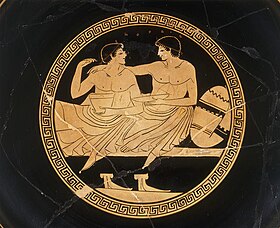
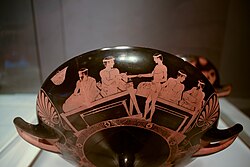
In classical antiquity, writers such as Herodotus, Plato, Xenophon, Athenaeus and many others explored aspects of homosexuality in Greek society. Plato, in his Laws, condemns homosexuality and calls it 'unnatural', although earlier he was favourable towards it. The most widespread and socially significant form of same-sex sexual relations in ancient Greece amongst elite circles was between adult men and pubescent or adolescent boys, known as pederasty (marriages in Ancient Greece between men and women were also age structured, with men in their thirties commonly taking wives in their early teens). Certain city-states allowed it while others were ambiguous or prohibited it. Though sexual relationships between adult men did exist, it is possible at least one member of each of these relationships flouted social conventions by assuming a passive sexual role according to Kenneth Dover, though this has been questioned by recent scholars. It is unclear how such relations between same-sex partners were regarded in the general society, especially for women, but examples do exist as far back as the time of Sappho.
The ancient Greeks did not conceive of sexual orientation as a social identity as modern Western societies have done. Greek society did not distinguish sexual desire or behavior by the gender of the participants, but rather by the role that each participant played in the sex act, that of active penetrator or passive penetrated. Within the traditions of pederasty, active/passive polarization corresponded with dominant and submissive social roles: the active (penetrative) role was associated with masculinity, higher social status, and adulthood, while the passive role was associated with femininity, lower social status, and youth.
Pederasty
Main article: Pederasty in ancient Greece
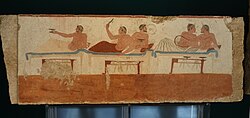
The most common form of same-sex relationships between elite males in Greece was paiderastia (pederasty). It was a relationship between an older male and an adolescent youth. A boy was considered a "boy" until he was able to grow a full beard. In Athens the older man was called erastes. He was to educate, protect, love, and provide a role model for his eromenos, whose reward for him lay in his beauty, youth, and promise. Such a concept is backed up by archeological evidence experts have found throughout the years, such as a bronze plaque of an older man carrying a bow and arrow while grabbing a younger man by the arms- who is carrying a goat. Furthermore, the boy's genitals are exposed in the plaque, thus experts interpret this, and more evidence comparative to this, as the practice of pederasty.
The roots of Greek pederasty lie in the tribal past of Greece, before the rise of the city-state as a unit of political organization. These tribal communities were organized according to age groups. When it came time for a boy to embrace the age group of the adult and to "become a man", he would leave the tribe in the company of an older man for a period of time that constituted a rite of passage. This older man would educate the youth in the ways of Greek life and the responsibilities of adulthood.
The rite of passage undergone by Greek youths in the tribal prehistory of Greece evolved into the commonly known form of Greek pederasty after the rise of the city-state, or polis. Greek boys no longer left the confines of the community, but rather paired up with older men within the confines of the city. These men, like their earlier counterparts, played an educational and instructive role in the lives of their young companions; likewise, just as in earlier times, they shared a sexual relationship with their boys. Penetrative sex, however, was seen as demeaning for the passive partner, and outside the socially accepted norm. In ancient Greece, sex was generally understood in terms of penetration, pleasure, and dominance, rather than a matter of the sexes of the participants. According to Dover, pederasty was not considered to be a homosexual act, given that the 'man' would be taking on a dominant role, and his disciple would be taking on a passive one. When intercourse occurred between two people of the same gender, it still was not entirely regarded as a homosexual union, given that one partner would have to take on a passive role, and would therefore no longer be considered a 'man' in terms of the sexual union. Hubbard and James Davidson argue however that there is insufficient evidence that a man was considered effeminate for being passive in sex alone. For example, the lowborn protagonist of Aristophanes' play The Knights openly admits to having been a passive partner.
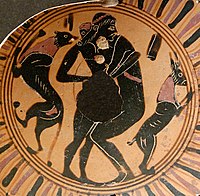
An elaborate social code governed the mechanics of Greek pederasty. It was the duty of the adult man to court the boy who struck his fancy, and it was viewed as socially appropriate for the younger man to withhold for a while before capitulating to his mentor's desires. At first, both erastes and eromenos, were expected to show restraint in the relationship. Soon after, the younger man gives in to his new mentor—erastes—and receives guidance from him. Nevertheless, it is not certain that those in submission will enjoy such "trainings" from his mentor—including sexual favors. However, it is important to note that not all pederastic relationships were sexual—many were simply forms of friendship and guidance.
The age limit for pederasty in ancient Greece seems to encompass, at the minimum end, boys of twelve years of age. To love a boy below the age of twelve was considered inappropriate, but no evidence exists of any legal penalties attached to this sort of practice. Traditionally, a pederastic relationship could continue until the widespread growth of the boy's body hair, when he is considered a man. Therefore, though relationships such as this were more temporary, it had longer, lasting effects on those involved. In ancient Spartan weddings, the bride had her hair cropped short and was dressed as a man. It was suggested by George Devereux that this was to make the husband's transition from homosexual to heterosexual relationships easier. This marks these pederasty relationships as temporary, developmental ones, not one of sexual and intimate connection like with a woman. During these times, homosexuality was seen as normal and necessary due to the power dynamic at play between an older, dominant man, and a younger, submissive one. Yet, when two men of similar age shared a similar relationship, it was deemed taboo and, in fact, perverse.
The ancient Greeks, in the context of the pederastic city-states, were the first to describe, study, systematize, and establish pederasty as a social and educational institution. It was an important element in civil life, the military, philosophy and the arts. There is some debate among scholars about whether pederasty was widespread in all social classes, or largely limited to the aristocracy.
In the military
Main article: Homosexuality in the militaries of ancient GreeceThe Sacred Band of Thebes, a separate military unit made up of pairs of male lovers, is usually considered the prime example of how the ancient Greeks used love between soldiers in a troop to boost their fighting spirit. The Thebans attributed to the Sacred Band the power of Thebes for the generation before its fall to Philip II of Macedon, who, when he surveyed the dead after the Battle of Chaeronea (338 BC) and saw the bodies of the Sacred Band strewn on the battlefield, delivered this harsh criticism of the Spartan views of the band:
Perish miserably they who think that these men did or suffered aught disgraceful.
Pammenes' opinion, according to Plutarch, was that
Homer's Nestor was not well skilled in ordering an army when he advised the Greeks to rank tribe and tribe...he should have joined lovers and their beloved. For men of the same tribe little value one another when dangers press; but a band cemented by friendship grounded upon love is never to be broken.
These bonds, reflected in episodes from Greek mythology, such as the heroic relationship between Achilles and Patroclus in the Iliad, were thought to boost morale as well as bravery due to the desire to impress and protect their lover. Such relationships were documented by many Greek historians and in philosophical discourses, as Plutarch demonstrates:
It is not only the most warlike peoples, the Boeotians, Spartans, and Cretans, who are the most susceptible to this kind of love but also the greatest heroes of old: Meleager, Achilles, Aristomenes, Cimon, and Epaminondas.
During the Lelantine War between the Eretrians and the Chalcidians, before a decisive battle the Chalcidians called for the aid of a warrior named Cleomachus (glorious warrior). He answered their request, bringing his lover to watch. Leading the charge against the Eretrians he brought the Chalcidians to victory at the cost of his own life. The Chalcidians erected a tomb for him in the marketplace in gratitude.
Love between adult men

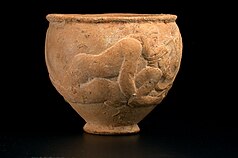
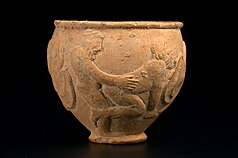 Anal sex between two males.Two sides of a Drinking cup. Greek; archaic period. 550-500 BCE
Anal sex between two males.Two sides of a Drinking cup. Greek; archaic period. 550-500 BCE
According to the opinion of the classicist Kenneth Dover who published Greek Homosexuality in 1978, given the importance in Greek society of cultivating the masculinity of the adult male and the perceived feminizing effect of being the passive partner, relations between adult men of comparable social status were considered highly problematic, and usually associated with social stigma. This stigma, however, was reserved for only the passive partner in the relationship. According to Dover and his supporters, Greek males who engaged in passive anal sex after reaching the age of manhood—at which point they were expected to take the reverse role in pederastic relationships and become the active and dominant member—thereby were feminized or "made a woman" of themselves. Dover refers to insults used in the plays of Aristophanes as evidence 'passive' men were ridiculed.
More recent work published by James Davidson and Hubbard have challenged this model, arguing that it is reductionist and have provided evidence to the contrary.
The legislator Philolaus of Corinth, lover of the stadion race winner Diocles of Corinth at the Ancient Olympic Games of 728 BC, crafted laws for the Thebans in the 8th century BC that gave special support to male unions, contributing to the development of Theban pederasty in which, unlike other places in ancient Greece, it favored the continuity of the union of male couples even after the younger man reached adulthood, the most famous example being the Sacred Band of Thebes, composed of elite soldiers in pairs of male lovers in the 4th century BC, as was also the case with him and Diocles, who lived together in Thebes until the end of their lives.
The romance between Pausanias and Agathon in Athens, made famous by their appearance in Plato's Symposium, also continued from the pederastic phase into adulthood as a stable and long-lasting relationship.
Achilles and Patroclus
Main article: Achilles and Patroclus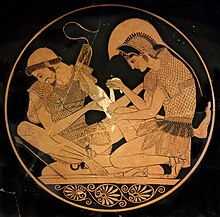
The first recorded appearance of a deep emotional bond between adult men in ancient Greek culture was in the Iliad (800 BC). Homer does not depict the relationship between Achilles and Patroclus as sexual. The ancient Athenians emphasised the supposed age difference between the two by portraying Patroclus with a beard in paintings and pottery, while Achilles is clean-shaven, although Achilles was an almost godlike figure in Greek society. This led to a disagreement about which to perceive as erastes and which eromenos among elites such as Aeschylus and Pausanias , since Homeric tradition made Patroclus out to be older but Achilles stronger. It has been noted, however, that the depictions of characters on pottery do not represent reality and may cater to the beauty standards of ancient Athens. Other ancients such as Xenophon held that Achilles and Patroclus were simply close friends.
Aeschylus in the tragedy Myrmidons made Achilles the erastes since he had avenged his lover's death even though the gods told him it would cost his own life. However, the character of Phaedrus in Plato's Symposium asserts that Homer emphasized the beauty of Achilles, which would qualify him, not Patroclus, as eromenos.
Theseus and Pirithous
Theseus and Pirithous are another famous pair of close adult male best friends of the same age whose strong bond has homoerotic connotations according to some ancient authors.
Pirithous had heard stories of Theseus's courage and strength in battle but wanted proof so he rustled Theseus's herd of cattle and drove it from Marathon and Theseus set out in pursuit. Pirithous took up his arms and the pair met to do battle but were so impressed with each other's gracefulness, beauty and courage they took an oath of friendship.
According to Ovid, Phaedra, Theseus' wife, felt left out by her husband's love for Pirithous and she used this as an excuse to try to convince her stepson, Hippolytus, to accept being her lover, as Theseus also neglected his son because he preferred to spend long periods with his companion.
Orestes and Pylades

Orestes and Pylades, similarly to Achilles and Patroclus, grew up together from childhood to adulthood. Their relationship is stronger and more intimate than any of their relationships with other people.
The relationship between them has been interpreted by some authors from Roman times onwards as romantic or homoerotic. The dialogue Erotes ("Affairs of the Heart"), attributed to Lucian, compares the merits and advantages of heteroeroticism and homoeroticism, and Orestes and Pylades are presented as the principal representatives of a loving friendship.
In 1734, George Frederic Handel's opera Oreste (based on Giangualberto Barlocci's Roman libretto of 1723), was premiered in London's Covent Garden. The fame of Lucian's works in the 18th century, as well as the generally well-known tradition of Greco-Roman heroic homoeroticism, made it natural for theatre audiences of that period to have recognized an intense, romantic, if not positively homoerotic quality, to the relationship between Orestes and Pylades.
Alexander and Hephaestion
Main article: Personal relationships of Alexander the Great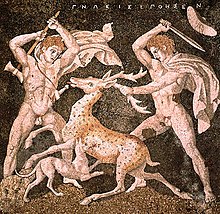
Alexander the Great had a close emotional attachment to his cavalry commander (hipparchus) and childhood friend, Hephaestion. He was "by far the dearest of all the king's friends; he had been brought up with Alexander and shared all his secrets." This relationship lasted throughout their lives, and was compared, by others as well as themselves, to that of Achilles and Patroclus.
Hephaestion studied with Alexander, as did a handful of other children of Ancient Macedonian aristocracy, under the tutelage of Aristotle. Hephaestion makes his appearance in history at the point when Alexander reaches Troy. There they made sacrifices at the shrines of the two heroes Achilles and Patroclus; Alexander honoring Achilles, and Hephaestion honoring Patroclus.
According to Robin Lane Fox, Alexander and Hephaestion were possible lovers. After Hephaestion's death in Oct 324 BC, Alexander mourned him greatly and did not eat for days. Alexander held an elaborate funeral for Hephaestion at Babylon, and sent a note to the shrine of Ammon, which had previously acknowledged Alexander as a god, asking them to grant Hephaestion divine honours. The priests declined, but did offer him the status of divine hero. Alexander died soon after receiving this letter; Mary Renault suggests that his grief over Hephaestion's death had led him to be careless with his health.
Alexander was overwhelmed by his grief for Hephaestion, so much that Arrian records that Alexander "flung himself on the body of his friend and lay there nearly all day long in tears, and refused to be parted from him until he was dragged away by force by his Companions". Some have suggested that they shared a homosexual relationship together, however the conservative author and politician Adonis Georgiades has challenged that claim, stating instead that Hephaestion was "his closest and dearest friend".
Love between adult women
Sappho, a poet from the island of Lesbos, wrote many love poems addressed to women and girls. The love in these poems is sometimes requited, and sometimes not. Sappho is thought to have written close to 12,000 lines of poetry. Of these, only about 600 lines have survived. As a result of her fame in antiquity, she and her land have become emblematic of love between women.
Pedagogic erotic relationships are also documented for Sparta, together with athletic nudity for women. During the year 610 B.C., a group of teenage girls was documented singing classic hymns about their Gods and Goddesses, as well as ties to them, while involved in ploughing rituals in a mountain range. Nevertheless, such hymns would further in content as the girls flirt with and tease one another with hints of sexual energy. Plato's Symposium mentions women who "do not care for men, but have female attachments". In general, however, the historical record of love and sexual relations between women is sparse.
Scholarship and controversy
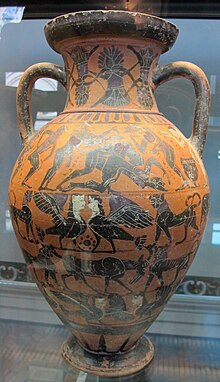
After a long hiatus marked by censorship of homosexual themes, modern historians picked up the threads, starting with Erich Bethe in 1907 and continuing with K. J. Dover and many others. These scholars have shown that same-sex relations were openly practised, largely with official sanction, in many areas of life from the 7th century BC until the Roman era.
Some scholars believe that same-sex relationships, especially pederasty, were common only among the aristocracy, and that such relationships were not widely practised by the common people (demos). One such scholar is Bruce Thornton, who argues that insults directed at pederastic males in the comedies of Aristophanes show the common people's dislike for the practice. Other scholars, such as Victoria Wohl [de], emphasize that in Athens, same-sex desire was part of the "sexual ideology of the democracy", shared by the elite and the demos, as exemplified by the tyrant-slayers, Harmodius and Aristogeiton. Even those who argue that pederasty was limited to the upper classes generally concede that it was "part of the social structure of the polis".
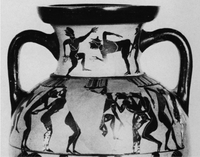
Considerable controversy has engaged the scholarly world concerning the nature of same-sex relationships among the ancient Greeks described by Thomas Hubbard in the Introduction to Homosexuality in Greece and Rome, A Source Book of Basic Documents, 2007, p. 2: "The field of Gay Studies has, virtually since its inception, been divided between 'essentialists' those who believe in an archetypical pattern of same gender attraction that is universal, transhistorical, and transcultural, and "social constructionists", those who hold that patterns of sexual preference manifest themselves with different significance in different societies and that no essential identity exists between practitioners of same-gender love in, for instance, ancient Greece and post industrial Western society. Some social constructionists have even gone so far as to deny that sexual preference was a significant category for the ancients or that any kind of subculture based on sexual object-choice existed in the ancient world", p. 2 (he cites Halperin and Foucault in the social constructionist camp and Boswell and Thorp in the essentialist; cf. E. Stein for a collection of essays, Forms of Desire: Sexual Orientation and the Social Constructionist Controversy, 1992). Hubbard states that "Close examination of a range of ancient texts suggests, however, that some forms of sexual preference were, in fact, considered a distinguishing characteristic of individuals. Many texts even see such preferences as inborn qualities and as "essential aspects of human identity..." ibid. Hubbard utilizes both schools of thought when these seem pertinent to the ancient texts, pp. 2–20.
During Plato's time there were people who were of the opinion that homosexual sex was shameful in any circumstances. Indeed, Plato himself eventually came to hold this view. At one time he had written that same-sex lovers were far more blessed than ordinary mortals. He even gave them a headstart in the great race to get back to heaven, their mutual love refeathering their mottled wings. Later he seemed to contradict himself. In his ideal city, he says in his last, posthumously published work known as The Laws homosexual sex will be treated the same way as incest. It is something contrary to nature, he insists, calling it "utterly unholy, odious-to-the-gods and ugliest of ugly things".
The subject has caused controversy in modern Greece. In 2002, a conference on Alexander the Great was stormed as a paper about his homosexuality was about to be presented. When the film Alexander, which depicted Alexander as romantically involved with both men and women, was released in 2004, 25 Greek lawyers threatened to sue the film's makers, but relented after attending an advance screening of the film.
Gallery
-
 Attic kylix depicting a lover and a beloved. Brygos Painter. Around 485 - 480 BCE. Ashmolean Museum
Attic kylix depicting a lover and a beloved. Brygos Painter. Around 485 - 480 BCE. Ashmolean Museum
-
 Pederastic scene. Kylix. Terracotta. Carpenter Painter. 510 - 500 BCE
Pederastic scene. Kylix. Terracotta. Carpenter Painter. 510 - 500 BCE
-
Pederastic couples. The outside of a drinking cup. Terracotta. Peithinos Painter. Around 500 BCE. Altes Museum
-
 Attic kylix depicting a lover and a beloved kissing. Artist: painter of Briseis. Around 480 BCE. Louvre Museum
Attic kylix depicting a lover and a beloved kissing. Artist: painter of Briseis. Around 480 BCE. Louvre Museum
-
 Pederastic courtship scenes. It has been commented that "Hares were popular love gifts in Athenian society... ...a hare can be seen siting tamely on the lap of one of the seated figures." The outside of an Attic cup. Kylix. Artist; Douris. Potter; Attributed to the Python potter. Around 480 BCE. J. Paul Getty Museum
Pederastic courtship scenes. It has been commented that "Hares were popular love gifts in Athenian society... ...a hare can be seen siting tamely on the lap of one of the seated figures." The outside of an Attic cup. Kylix. Artist; Douris. Potter; Attributed to the Python potter. Around 480 BCE. J. Paul Getty Museum
-
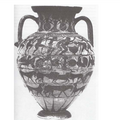 Pederastic sex. Tyrrhenian amphora. 560 - 530 BCE.
Pederastic sex. Tyrrhenian amphora. 560 - 530 BCE.
-
 Pederastic sex. Detail of a Tyrrhenian amphora. 560 - 530 BCE.
Pederastic sex. Detail of a Tyrrhenian amphora. 560 - 530 BCE.
-
 Pederastic scene. Bowl. Ancient Greek. Athens National museum
Pederastic scene. Bowl. Ancient Greek. Athens National museum
-
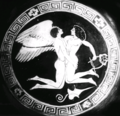 Hyacinthus and Zephyrus. Attic Kylix. 500 - 450 BCE
Hyacinthus and Zephyrus. Attic Kylix. 500 - 450 BCE
-
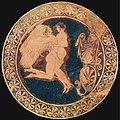 Hyacinthus and Zephyrus. Figure on the left may also be Eros. Around 480 BCE. Museum of Fine Arts, Boston
Hyacinthus and Zephyrus. Figure on the left may also be Eros. Around 480 BCE. Museum of Fine Arts, Boston
-
 A fragment of a kylix with winged Eros and a boy. It shows Intercrural sex between the two figures. Around 490 to 480 BCE. J. Paul Getty Museum.
A fragment of a kylix with winged Eros and a boy. It shows Intercrural sex between the two figures. Around 490 to 480 BCE. J. Paul Getty Museum.
-
 Two males bumping buttocks together. Two figures either side are dancing. Kylix. Attributed to the Manner of Epeleios Painter. 525 - 475 BCE
Two males bumping buttocks together. Two figures either side are dancing. Kylix. Attributed to the Manner of Epeleios Painter. 525 - 475 BCE
See also
- Eromenos
- Erotic art in Pompeii and Herculaneum
- Greek love
- History of erotic depictions
- History of homosexuality
- History of human sexuality
- Homosexuality in ancient Rome
- Homosexuality in China
- Homosexuality in India
- Homosexuality in Japan
- Homosexuality in the militaries of ancient Greece
- Kagema
- LGBT rights in Greece
- Pederasty in ancient Greece
- Malakia
- Pederasty
- The Sacred Band of Stepsons
- Sacred Band of Thebes
- Wakashū
Notes
- ^ Jared Alan Johnson (2015). "The Greek Youthening: Assessing the Iconographic Changes within Courtship during the Late Archaic Period." (Master's thesis). University of Tennessee. Retrieved 5 May 2024.
- Herodotus Histories 1.135 Archived 2022-03-26 at the Wayback Machine
- Plato, Phaedrus 227a Archived 2022-05-15 at the Wayback Machine
- Xenophon, Memorabilia 2.6.28 Archived 2022-04-01 at the Wayback Machine, Symposium 8 Archived 2022-01-04 at the Wayback Machine
- Athenaeus, Deipnosophistae 13:601–606 Archived 2012-07-28 at the Wayback Machine
- Pickett, Brent (2021), Zalta, Edward N. (ed.), "Homosexuality", The Stanford Encyclopedia of Philosophy (Spring 2021 ed.), Metaphysics Research Lab, Stanford University, retrieved 2025-01-06
- Xen. Oec. 7.5 Archived 2022-03-22 at the Wayback Machine
- Cohen, David (1994). Law, Sexuality, and Society: The Enforcement of Morals in Classical Athens. Cambridge University: Cambridge University Press. p. 6. ISBN 9780521466424.
- ^ Oxford Classical Dictionary entry on homosexuality, pp.720–723; entry by David M. Halperin.
- ^ Donnay, Catherine S., "Pederasty in ancient Greece: a view of a now forbidden institution" (2018). EWU Masters Thesis Collection. 506. http://dc.ewu.edu/theses/506
- "The Greeks - Homosexuality". www.pbs.org. Retrieved 2023-12-05.
- Martha C. Nussbaum, Sex and Social Justice (Oxford University Press, 1999), pp. 268, 307–308, 335; Gloria Ferrari, Figures of Speech: Men and Maidens in Ancient Greece (University of Chicago Press, 2002), p. 144–5.
- Davidson, James (2001). "Dover, Foucault and Greek Homosexuality: Penetration and the Truth of Sex". Past & Present. doi:10.1093/past/170.1.3.
- Aristophanes. Knights. 1255
- ^ Holmen, Nicole. 2010. Examining Greek Pederastic Relationships Archived 2023-03-17 at the Wayback Machine. Inquiries Journal/Student Pulse 2 (02).
- Marilyn B. Skinner, Sexuality in Greek and Roman Culture 2nd edition (United Kingdom: John Wiley & Sons, 2014), 16-18.
- Cartledge, Paul (1981). "Spartan Wives: Liberation or License?". Classical Quarterly. 31 (1): 101. doi:10.1017/S0009838800021091. S2CID 170486308.
- Chloë Taylor, The Routledge Guidebook to Foucault’s The History of Sexuality (New York: Routledge, 2017), 217.
- Cavanaugh, Mariah. “Ancient Greek Pederasty: Education or Exploitation?” Web log. StMU Research Scholars (blog). St. Mary’s University, December 3, 2017. https://stmuscholars.org/ancient-greek-pederasty-education-or-exploitation/#marker-77603-10.
- Golden M. – Slavery and homosexuality in Athens. Phoenix 1984 XXXVIII : 308–324
- Plutarch (1917). "Pelopidas 18.5". In Bernadotte Perrin (ed.). Plutarch's Lives. Vol. V. W. Heinemann. pp. 385–387. ISBN 978-0-674-99113-2. Archived from the original on 2023-04-24. Retrieved 2020-02-08.
- "Plutarch, Amatorius, section 17".
- John R Clarke (1998). Looking at Lovemaking. University of California Press. p. 38. ISBN 9780520229044.
- Meredith G. F. Worthen (10 June 2016). Sexual Deviance and Society: A Sociological Examination. Routledge. pp. 160–. ISBN 978-1-317-59337-9. Archived from the original on 24 April 2023. Retrieved 20 January 2018.
- Hubbard, T. K. (1998). "Popular Perceptions of Elite Homosexuality in Classical Athens". Arion: A Journal of Humanities and the Classics. 6 (1): 48–78. JSTOR 20163707. Archived from the original on 2022-02-20. Retrieved 2021-10-16.
- Aristotle. Politics, 1274a31–b5 Archived 2022-09-13 at the Wayback Machine.
- Romm, J. (2021, June 6). The legacy of same-sex love in ancient Thebes Archived 2022-09-13 at the Wayback Machine. History News Network, Columbian College of Arts & Sciences. Retrieved September 13, 2022
- Plato, Symposium 179–80 Archived 2022-05-06 at the Wayback Machine.
- "PLUTARCH, THESEUS". classics.mit.edu. Archived from the original on 2011-07-28. Retrieved 2022-09-11.
- "OVID, HEROIDES IV - Theoi Classical Texts Library". www.theoi.com. Archived from the original on 2022-09-11. Retrieved 2022-09-11.
- Ovid's Heroides, 4 Archived 2022-09-11 at the Wayback Machine
- Chugg, Andrew (2006). Alexander's Lovers. Raleigh, N.C.: Lulu Archived 2023-04-24 at the Wayback Machine. ISBN 978-1-4116-9960-1, pp 78-79.
- Curtius 3.12.16
- Fox (1980) p. 67.
- Arrian 7.14.13
- Georgiades, Adonis (2004). Homosexuality In Ancient Greece The Myth Is Collapsing. p. 187.
- ^ "Why were the ancient Greeks so confused about homosexuality, asks James Davidson". the Guardian. 2007-11-10. Archived from the original on 2021-10-21. Retrieved 2021-10-21.
- Plato, Symposium 191e Archived 2016-12-21 at the Wayback Machine
- Rictor Norton, Critical Censorship of Gay Literature Archived 2017-07-15 at the Wayback Machine
- ^ Thornton, pp. 195–6.
- Wohl, pp. 6–7.
- Davidson, James. "Why Were The Ancient Greeks So Confused About Homosexuality, Asks James Davidson" The Guardian, 2007
- "CNN.com - Too gay for Greeks: Lawyers threaten 'Alexander' suit - Nov 25, 2004". edition.cnn.com. Retrieved 2024-09-13.
- "Bisexual Alexander angers Greeks". BBC News. 2004-11-22. Archived from the original on 2009-02-14. Retrieved 2006-08-25.
- "Greek lawyers halt Alexander case". BBC News. 2004-12-03. Archived from the original on 2017-12-05. Retrieved 2006-08-25.
- Shapiro, H. A. (April 1981). "Courtship Scenes in Attic Vase-Painting". American Journal of Archaeology. 85 (2). The University of Chicago Press: 135, 143, 145. doi:10.2307/505033. JSTOR 505033. Archived from the original on 14 April 2022.
- Brendle, Ross (April 2019). "The Pederastic Gaze in Attic Vase-Painting". Arts. 8 (2): 47. doi:10.3390/arts8020047.
- ^ J. Paul Getty Museum. "Attic Red-Figure Cup". www.getty.edu. J. Paul Getty Museum. Retrieved 8 August 2024.
Literature
- Calimach, Andrew, Lovers' Legends: The Gay Greek Myths, New Rochelle, Haiduk Press, 2002, ISBN 978-0-9714686-0-3
- Cohen, David, "Law, Sexuality, and Society: The Enforcement of Morals in Classical Athens". Cambridge University Press, 2004. ISBN 0-521-46642-3.
- Lilar, Suzanne, Le couple (1963), Paris, Grasset; Translated as Aspects of Love in Western Society in 1965, with a foreword by Jonathan Griffin, New York, McGraw-Hill, LC 65–19851.
- Dover, Kenneth J. Greek Homosexuality. Vintage Books, 1978. ISBN 0-394-74224-9
- Halperin, David. One Hundred Years of Homosexuality: And Other Essays on Greek Love. Routledge, 1989. ISBN 0-415-90097-2
- Hornblower, Simon and Spawforth, Antony, eds. The Oxford Classical Dictionary, third edition. Oxford University Press, 1996. ISBN 0-19-866172-X
- Hubbard, Thomas K. Homosexuality in Greece and Rome.; University of California Press, 2003. ISBN 0-520-23430-8
- Percy, III, William A. Pederasty and Pedagogy in Archaic Greece. University of Illinois Press, 1996. ISBN 0-252-02209-2
- Thornton, Bruce S. Eros: the Myth of Ancient Greek Sexuality. Westview Press, 1997. ISBN 0-8133-3226-5
- Wohl, Victoria. Love Among the Ruins: the Erotics of Democracy in Classical Athens. Princeton University Press, 2002. ISBN 0-691-09522-1
External links
Library resources aboutHomosexuality in ancient Greece
 Media related to LGBT history in ancient Greece at Wikimedia Commons
Media related to LGBT history in ancient Greece at Wikimedia Commons- Pederasty and Pedagogy In Archaic Greece
- Homosexuality in History: A Partially Annotated Bibliography.
- Ancient Greek Homosexuality
- Generally speaking, sexuality in Ancient Athens was well recorded. These ancient artifacts tell the entire story in pictures.
| LGBTQ history | |||||||||||||||||||
|---|---|---|---|---|---|---|---|---|---|---|---|---|---|---|---|---|---|---|---|
| By regions |
| ||||||||||||||||||
| Timelines |
| ||||||||||||||||||
| By topic |
| ||||||||||||||||||
| Related | |||||||||||||||||||